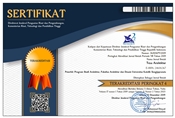PENGARUH FAKTOR NON FISIK TERHADAP PEMBENTUKAN POLA RUANG BANGUNAN PADA RUMOH ACEH DI KABUPATEN ACEH BESAR (The Effect of non-physical factors to form the building space pattern of Rumoh aceh at Aceh Besar)
Abstract
Keywords
Full Text:
PDFReferences
Arif, K. 2006. Ragam Citra Kota Banda Aceh. Disertasi Program Doktor Arsitektur. (Tidak Dipublikasikan). Jurusan Arsiteltur. Universitas Katolik Parahyangan. Bandung.
Burhan, I., M, Antariksa, Meidiana, C. 2008. Pola Tata Ruang Permukiman Tradisional Gampong Lubuk Sukon, Kabupaten Aceh Besar. Arsitektur ejournal, III(1): 172-189 (diakses tanggal 4 Janari 2014).
Dwijendra, N., K., A. 2003. Perumahan dan Permukiman Tradisional Bali. JURNAL PERMUKIMAN NATAH. I (1): 8-24 (diakses tanggal 4 Maret 2014).
Haryadi & Setiawan, B. 1995. Arsitektur Lingkungan dan Perilaku. Jakarta: P3SL Dirjen Dikti, Depdikbud.
Rapoport, A. 1990. History And Precedent In Environmental Design. New York: Plenum Press.
Suprijanto, I. 2002. Rumah Tradisional Osing: Konsep Ruang Dan BentukJurnal Dimensi Teknik Arsitektur. XXX(1): 10-20 (diakses tanggal 12 Maret 2014).
Yudhohusodo, S., Salam, S., Djoekardi,D., Sardjono, Suryono, Subagio, W. Nirwhono, L., Purbokusumo, W., Nazar F., Wiramiharja, S., Muhyanto, A. Aziz
Sasmitahardja, Soemadi, Soedarmadi.1991. Rumah untuk Seluruh Rakyat. Jakarta: Yayasan Padamu Negeri.
Ulfa, S., M. 2011. Pola Tata Ruang Dalam Rumah Tinggal Kuno Desa Bakung Kecamatan Udanawu Blitar. Jurnal TESA Arsitektur, IX(2): 62-122 (diakses tanggal 12 Maret 2014).
Wilson, F. 1971. Structure the Essence of Architecture. New York : Van Nostrand Reinhold Company.
DOI: https://doi.org/10.24167/tesa.v12i2.388
ISSN 1410-6094 (Print) | ISSN 2460-6367 (Media Online) | View My Stats

This work is licensed under a Creative Commons Attribution 4.0 International License.








